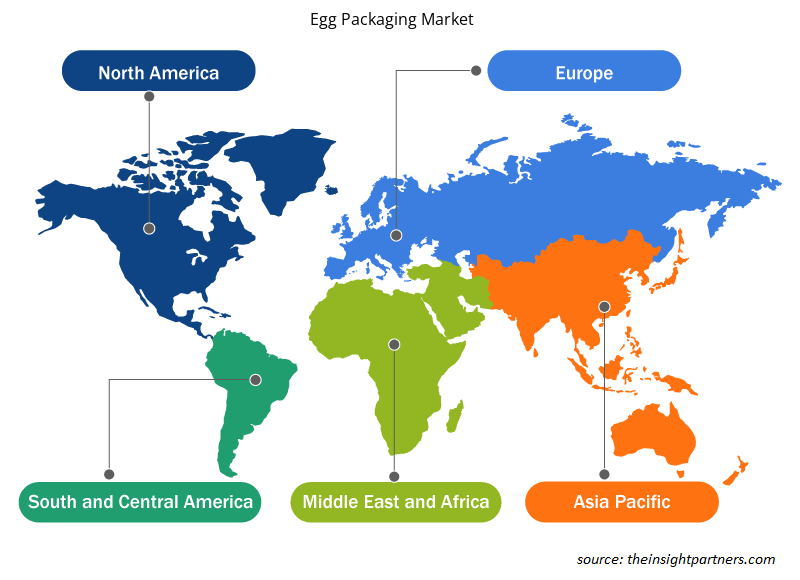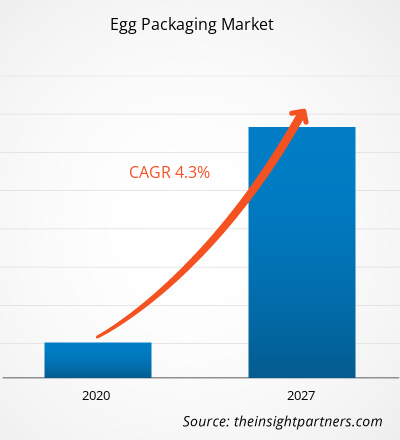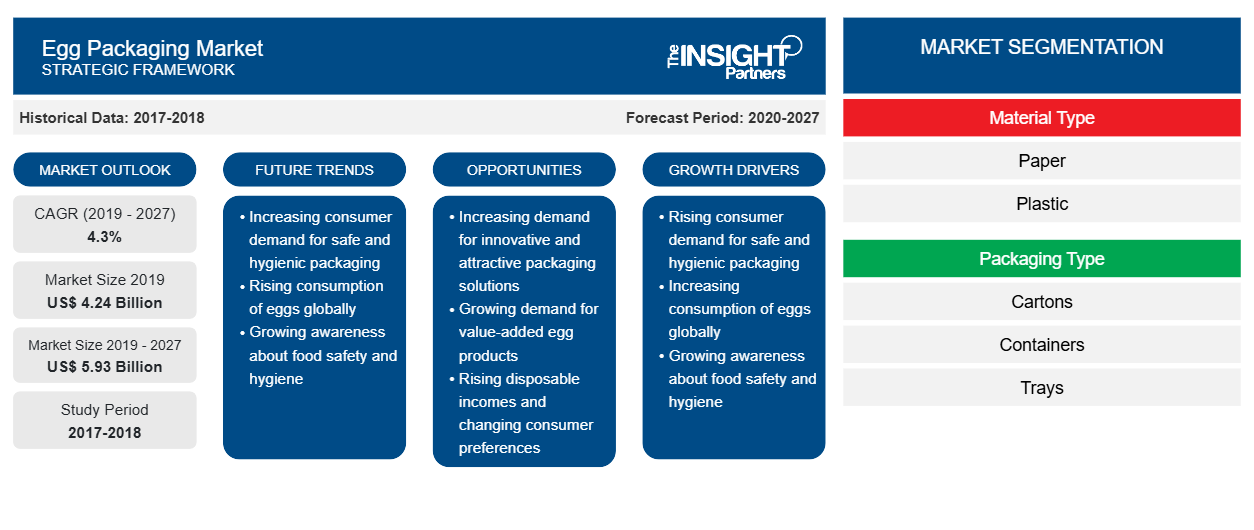El mercado de envases de huevos se valoró en US$ 4.243,42 millones en 2019 y se proyecta que alcance los US$ 5.932,01 millones en 2027; se espera que crezca a una CAGR del 4,3% entre 2020 y 2027.
El embalaje de huevos se refiere a un material de embalaje diseñado específicamente para el almacenamiento y transporte seguros de huevos. La naturaleza delicada y porosa de las cáscaras de huevo exige una solución de embalaje resistente y segura. Los cartones, bandejas, cestas y contenedores son algunas de las soluciones de embalaje de huevos más utilizadas. Se fabrican con cartón, papel reciclado, tereftalato de polietileno o poliestireno. Estos materiales brindan comodidad y también ayudan a absorber la tensión o el impacto ejercidos durante la manipulación o el transporte de los huevos. No obstante, el embalaje de huevos preserva los huevos de bacterias, contaminación, depredadores naturales y pérdida de humedad. Todos estos beneficios han aumentado la demanda de embalajes de huevos.
En 2019, Europa tuvo una participación significativa en el mercado de envasado de huevos . Sin embargo, se espera que Asia Pacífico sea la región de más rápido crecimiento durante el período de pronóstico. El crecimiento del mercado de envasado de huevos en Europa se atribuye principalmente al creciente consumo de huevos y al aumento de la demanda de la industria de servicios de alimentos y procesamiento de alimentos.
El brote de COVID-19 se informó por primera vez en Wuhan (China) durante diciembre de 2019. A febrero de 2021, Estados Unidos, Brasil, India, Rusia, España y el Reino Unido se encuentran entre los países más afectados en términos de casos confirmados y muertes reportadas. El brote está afectando negativamente a las economías e industrias en varios países debido a los bloqueos, las prohibiciones de viaje y los cierres comerciales. La alimentación y las bebidas es una de las principales industrias del mundo que sufre graves interrupciones, como interrupciones de la cadena de suministro, cancelaciones de eventos tecnológicos y cierres de oficinas. Por ejemplo, China es el centro de fabricación mundial y el mayor proveedor de materias primas para varias industrias y se encuentra entre los países más afectados. El cierre de varias plantas y fábricas en China ha restringido las cadenas de suministro globales e interrumpido las actividades de fabricación, los cronogramas de entrega y las ventas de varios productos. Varias empresas ya han anunciado posibles retrasos en las entregas de productos y una caída en las ventas futuras de sus productos. Además, las prohibiciones de viaje globales impuestas por países de Europa, Asia y América del Norte están obstaculizando las colaboraciones comerciales y las oportunidades de asociación. Todos estos factores están obstaculizando la industria de alimentos y bebidas y, por lo tanto, actúan como factores restrictivos para el crecimiento de varios mercados relacionados con esta industria.
Personalice este informe según sus necesidades
Obtendrá personalización en cualquier informe, sin cargo, incluidas partes de este informe o análisis a nivel de país, paquete de datos de Excel, así como también grandes ofertas y descuentos para empresas emergentes y universidades.
-
Obtenga las principales tendencias clave del mercado de este informe.Esta muestra GRATUITA incluirá análisis de datos, desde tendencias del mercado hasta estimaciones y pronósticos.
Perspectivas del mercado
Creciente preferencia por la comodidad en el transporte de huevos
El embalaje de huevos es una parte esencial para proporcionar huevos de calidad a los consumidores. Preserva los huevos de bacterias, contaminación, depredadores naturales y pérdida de humedad. Además, el embalaje de huevos protege contra posibles aplastamientos durante la manipulación, almacenamiento o transporte de los huevos. Numerosos huevos se rompen durante el transporte en comparación con cualquier otro paso durante el procesamiento y la distribución. Por lo tanto, el daño económico causado por los huevos rotos, ya que la aparición de grietas aumenta el riesgo de contaminación bacteriana de los huevos rotos, lo que reduce la calidad y causa problemas de seguridad alimentaria. Por lo tanto, el embalaje de huevos en forma de bandejas, cajas de cartón o cartones se utiliza principalmente para envasar los huevos. Los cartones pueden brindar la mejor protección mecánica para los huevos. Los cartones tienen una forma con hoyuelos y la estructura ayuda a proteger los huevos contra tensiones y golpes ejercidos durante el almacenamiento y el transporte, lo que frena el posible daño o aplastamiento de las cáscaras de huevo. Por lo tanto, los fabricantes están introduciendo cajas de huevos de múltiples formas y tamaños para brindar comodidad para el almacenamiento y transporte de los huevos. Por lo tanto, la creciente preferencia por los productos de envasado de huevos en forma de bandejas, cajas de cartón o cartones para transportar huevos está impulsando el crecimiento del mercado de envasado de huevos.
Información sobre el tipo de material
Según el tipo de material, el mercado de envases para huevos se segmenta en papel, plástico y otros. El segmento de papel lideró el mercado con la mayor participación de mercado en 2019. Los envases de papel protegen los productos y reducen los residuos, además de ser reciclables. El reciclaje responsable de papel y envases usados reduce la basura y los vertederos. Previene el desperdicio por rotura, deterioro y contaminación, y extiende la vida útil del producto. Los envases de papel son un método versátil y rentable para transportar, proteger y conservar una amplia gama de artículos. Está diseñado para ser resistente, pero ligero, y se puede personalizar para satisfacer las necesidades específicas del producto o del cliente. Los envases de papel están hechos de pulpa de papel. Su diseño no ha cambiado mucho desde entonces. Fue reemplazado por un tiempo por envases de PET, pero el público prefirió el aspecto y la sensación naturales del cartón de pulpa de papel. Los cartones de huevos de papel son biodegradables y aceptados por casi todas las agencias de reciclaje locales. Todos estos factores están impulsando el crecimiento del mercado de envases de huevos para el segmento de papel.
Algunos actores clave del mercado son Sonoco Products Company; Placon; Mauser Corporate GMBH; JIN FU HUA PACKAGING INDUSTRIAL CO., LTD.(JFH); Huhtamaki Oyj; CKF Inc.; Cascades Inc; Brodrene Hartmann AS; Reynolds Group Holdings Limited.; y Cellulose de la Loire. Los principales actores que operan en el mercado de envases para huevos se centran en estrategias como fusiones y adquisiciones, y lanzamientos de productos para aumentar su presencia geográfica y su base de consumidores a nivel mundial. Sonoco Products Company; Placon; Mauser Corporate GMBH; JIN FU HUA PACKAGING INDUSTRIAL CO., LTD.(JFH); Huhtamaki Oyj; CKF Inc.; Cascades Inc; Brodrene Hartmann AS; Reynolds Group Holdings Limited.; and Cellulose de la Loire. Major players operating in the egg packaging market are focused on strategies such as mergers and acquisitions, and product launches to increase their geographical presence and consumer base globally.
Perspectivas regionales del mercado de envasado de huevos
Los analistas de Insight Partners explicaron en detalle las tendencias y los factores regionales que influyen en el mercado de envases de huevos durante el período de pronóstico. Esta sección también analiza los segmentos y la geografía del mercado de envases de huevos en América del Norte, Europa, Asia Pacífico, Oriente Medio y África, y América del Sur y Central.

- Obtenga datos regionales específicos para el mercado de envasado de huevos
Alcance del informe de mercado de envases de huevos
| Atributo del informe | Detalles |
|---|---|
| Tamaño del mercado en 2019 | US$ 4.24 mil millones |
| Tamaño del mercado en 2027 | 5.93 mil millones de dólares estadounidenses |
| CAGR global (2019-2027) | 4,3% |
| Datos históricos | 2017-2018 |
| Período de pronóstico | 2020-2027 |
| Segmentos cubiertos |
Por tipo de material
|
| Regiones y países cubiertos |
América del norte
|
| Líderes del mercado y perfiles de empresas clave |
|
Densidad de actores del mercado de envases de huevos: comprensión de su impacto en la dinámica empresarial
El mercado de envases para huevos está creciendo rápidamente, impulsado por la creciente demanda de los usuarios finales debido a factores como la evolución de las preferencias de los consumidores, los avances tecnológicos y una mayor conciencia de los beneficios del producto. A medida que aumenta la demanda, las empresas amplían sus ofertas, innovan para satisfacer las necesidades de los consumidores y aprovechan las tendencias emergentes, lo que impulsa aún más el crecimiento del mercado.
La densidad de actores del mercado se refiere a la distribución de las empresas o firmas que operan dentro de un mercado o industria en particular. Indica cuántos competidores (actores del mercado) están presentes en un espacio de mercado determinado en relación con su tamaño o valor total de mercado.
Las principales empresas que operan en el mercado de envasado de huevos son:
- Compañía de productos Sonoco
- Placón
- Mauser Corporativo GMBH
- JIN FU HUA EMPAQUE INDUSTRIAL CO.,LTD.(JFH)
- Compañía Huhtamaki
Descargo de responsabilidad : Las empresas enumeradas anteriormente no están clasificadas en ningún orden particular.

- Obtenga una descripción general de los principales actores clave del mercado de envases de huevos
Informe Destacado
- Tendencias progresivas de la industria en el mercado mundial de envasado de huevos para ayudar a los actores a desarrollar estrategias efectivas a largo plazo
- Estrategias de crecimiento empresarial adoptadas por los mercados desarrollados y en desarrollo
- Análisis cuantitativo del mercado mundial de envases para huevos de 2017 a 2027
- Estimación de la demanda de envases para huevos en diversas industrias
- Análisis PEST para ilustrar la eficacia de los compradores y proveedores que operan en la industria para predecir el crecimiento del mercado
- Desarrollos recientes para comprender el escenario competitivo del mercado y la demanda de envases para huevos
- Tendencias y perspectivas del mercado junto con los factores que impulsan y restringen el crecimiento del mercado de envases de huevos
- Proceso de toma de decisiones mediante la comprensión de las estrategias que sustentan el interés comercial con respecto al crecimiento del mercado mundial de envases de huevos
- Tamaño del mercado de envases de huevos en varios nodos del mercado
- Descripción detallada y segmentación del mercado mundial de envases para huevos, así como su dinámica en la industria.
- Tamaño del mercado de envasado de huevos en varias regiones con oportunidades de crecimiento prometedoras
Mercado de envases para huevos, por tipo de material
-
Papel
- Cartón
- Papel reciclado
- Otros
-
Plástico
- Tereftalato de polietileno
- Poliestireno
- Otros
- Otros
Mercado de embalajes para huevos, por tipo de embalaje
- Cajas de cartón
- Contenedores
- Bandejas
- Otros
Perfiles de empresas
- Compañía de productos Sonoco
- Placón
- Mauser Corporativo GMBH
- JIN FU HUA EMPAQUE INDUSTRIAL CO.,LTD.(JFH)
- Compañía Huhtamaki
- Compañía CKF Inc.
- Cascadas Inc.
- Brodrene Hartmann AS
- Grupo Reynolds Holdings Limitada.
- Celulosa del Loira
- Análisis histórico (2 años), año base, pronóstico (7 años) con CAGR
- Análisis PEST y FODA
- Tamaño del mercado, valor/volumen: global, regional y nacional
- Industria y panorama competitivo
- Conjunto de datos de Excel
Informes recientes
Informes relacionados
Testimonios
Razón para comprar
- Toma de decisiones informada
- Comprensión de la dinámica del mercado
- Análisis competitivo
- Información sobre clientes
- Pronósticos del mercado
- Mitigación de riesgos
- Planificación estratégica
- Justificación de la inversión
- Identificación de mercados emergentes
- Mejora de las estrategias de marketing
- Impulso de la eficiencia operativa
- Alineación con las tendencias regulatorias























 Obtenga una muestra gratuita para - Mercado de envases de huevos
Obtenga una muestra gratuita para - Mercado de envases de huevos